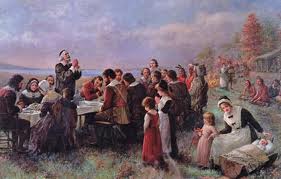What Did They Really Eat at the First Thanksgiving?

(The First Thanksgiving)
As a former elementary school teacher, I spent many Novembers teaching about the Pilgrims, the Wampanoag Native Americans, and the first Thanksgiving. We set up dramatic play centers in our classroom where the children could pretend to be Pilgrims and Wampanoags. We would also construct a model of the Mayflower and the kids would help me make all of the little Pilgrims and supplies that went inside the ship. We usually had a Thanksgiving Feast the day before Thanksgiving break where the children would bring a food assignment and dress-up like a Pilgrim or Indian. We read lots of books about the first Thanksgiving. One of my favorite books on the subject was titled, If You Were At The First Thanksgiving, written by Anne Karma. This delightful, little book teaches all sorts of interesting facts about the first Thanksgiving. One section of the book that I thought was especially interesting was the section about the foods they ate the first Thanksgiving.
When we think of Thanksgiving dinner, the first food that comes to mind is turkey. It is possible that there were turkeys at the first Thanksgiving, but we don't know for sure. We do know that wild turkeys were native to the region surrounding Plymouth. We also know that there were several types of "wildfowl" served at the first Thanksgiving. Most historians believe that the wildfowl they ate was more likely to be goose, duck, and pheasant. The birds were probably roasted and stuffed, but with a different kind of stuffing than we use today. Their stuffing was made of onions and herbs and possibly some cornmeal with cranberries. They called it "pudding in the belly."
Game fowl wasn't the only meat served at the first Thanksgiving. Their village was close to the ocean, so they also ate seafood such cod, sea bass, and stewed eels. They may have eaten clams, mussels, and oysters although the Pilgrims weren't too fond of shellfish. The Wampanoags brought 5 deer to the feast. This was a special treat for the Pilgrims. In England, only the rich people could afford to eat venison because they would hunt them in their private forests. In America, no one owned the forests or the deer.
Historians believe the Wampanoags also helped provide vegetables to eat. The Pilgrims were grateful for fresh food after months of living on stale and salty food that didn't taste very good. They probably ate beans, onions, lettuce, spinach, squash, carrots, cabbage, and peas, all of which were native to the region. Corn was likely at the feast too, but they didn't eat it on the cob like we do. They would remove the corn from the cob, pound it into a sort of cornmeal mush and eat it. Pumpkins may have been at the feast, but there was no pumpkin pie. They didn't have any sugar, butter, or wheat flour at the first Thanksgiving. It is also interesting to note that there were no potatoes at the first Thanksgiving. Potatoes were native to South America and they only begun to be introduced to the Europeans around the same time the Pilgrims left for the new world.
Now that you know more about the food they really ate at the first Thanksgiving, maybe you could add something more historical to your feast this year. Stewed eels, anyone?
- https://www.history.com/topics/thanksgiving/first-thanksgiving-meal
- https://www.smithsonianmag.com/ist/?next=/history/what-was-on-the-menu-at-the-first-thanksgiving-511554/
 Cristina Duke
Cristina Duke
Monthly Newsletter Contributor since 2014
Email the author! cristina@dvo.com
